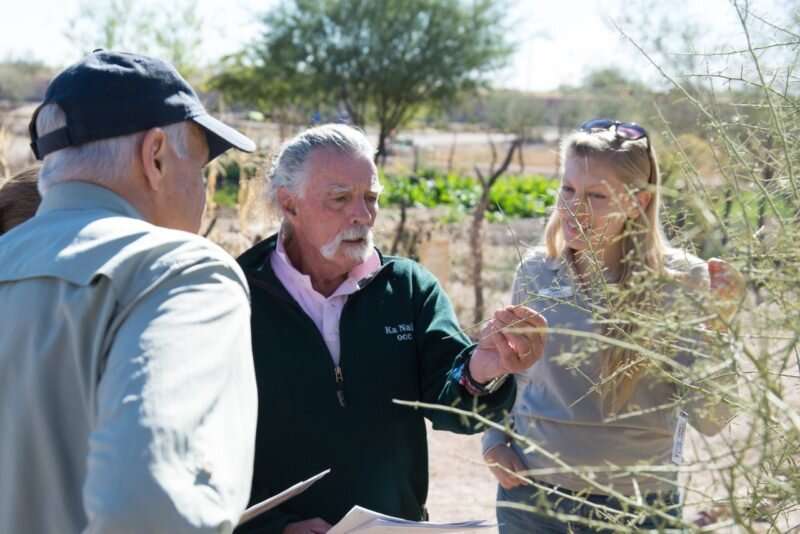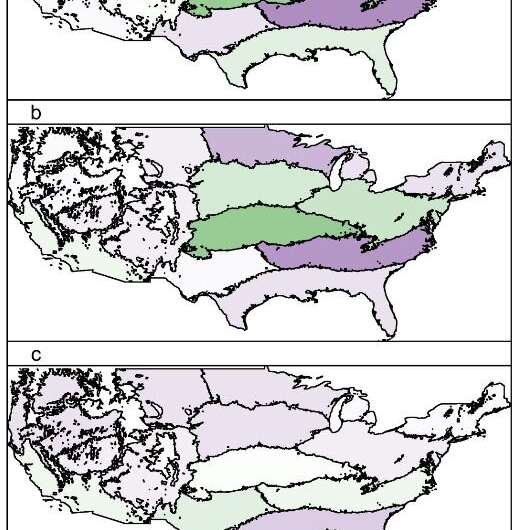Advancing spring warmth could disrupt species migration, development

The spring season is lengthening in some regions of the U.S. and compressing in others, potentially disrupting species' migration patterns and development, a new study finds.
In a new study in the AGU journal Geophysical Research Letters, scientists found that in many areas of the U.S. springtime temperature thresholds important for plant and animal life cycles occur between six to 20 days earlier in the season than they did 70 years ago.
These changes in the length and timing of the spring season could impact animal migratory patterns and disrupt many species' development, according to the study's authors.
Most plant and animal species rely on the build-up of heat in spring to signal biological processes like flowering, breeding and hatching of insect eggs. Based on the amount of heat accumulated, scientists can estimate how many days into the year it will take for a species to start these processes.
In the new study, researchers analyzed 70 years of springtime temperature data and compared this with long-term observations of plant and animal activity. The researchers examined three checkpoints of heat accumulation, or thresholds, that occur at different points in the growing season and indicate when most species begin spring development. The researchers found temperature thresholds for early, middle, and late spring development are advancing significantly within several regions of the U.S.
Understanding how the timing of spring development thresholds has changed over the past 70 years could help scientists better predict how climate change may affect species into the future, said Theresa Crimmins, associate director of the U.S. National Phenology Network at the University of Arizona and the study's lead author.
Changes in the timing of plant and animal development could lead to competition for resources, opportunities for invasive species to take root and mismatches between symbiotic species, she said.
"We see a very clear pattern of earlier timing to events in many parts of the country—though not everywhere," Crimmins said. "Anywhere we saw a significant trend it was advancing, meaning that the event is occurring earlier now than in previous decades."

Uneven advances in warmth
Previous research found that with spring temperatures in the U.S. increasing over the past century, the timing of spring development for many species is changing. But while previous studies focused on monthly average temperatures, the new study focuses on a range of temperatures specifically relevant to species' springtime development. This gives scientists a more accurate picture of how warming temperatures are affecting the timing of different species' spring activity, according to the study's authors.
"One of this study's biggest contributions is the fact that we evaluated thresholds that encompass the whole growing season," Crimmins said. "Seeing differential responses among those thresholds in different regions gives us a lot of insight into how species that are active at those times of the season may be responding."
The day of year each threshold is met depends on the weather and varies by region. For the thresholds evaluated in the new study, the earliest occurs between late January and late May, the next between mid-March and early July, and the latest between mid-April and late July.
The Northeast, Ohio Valley, and most Western regions all showed advancements in the day of the year when these temperature thresholds are met. In most of these regions, the thresholds are being met about six to ten days earlier than they were 70 years ago—advancing by an average of about one day per decade. In the Southwest, the season is advancing even faster—thresholds there are being met about 18-20 days earlier than 70 years ago, a rate of nearly three days per decade.
The new study also found temperature thresholds are advancing at different rates from region to region. In the Ohio Valley region, for example, the first temperature threshold that occurs around late April is advancing rapidly, but the second threshold in late May is not—lengthening the season by a little more than four days. But other regions show the opposite trend—like the Northeast, where the length of time between the same thresholds has compressed by about two days.
Changes in the arrival of spring are especially important for migratory species traveling north. Due to different rates of spring advancement across regions, species in the East may need to speed up their migration in order to keep pace with the food supply, while species in the West may need to slow down, Crimmins said.
Changes in the length and timing of spring could also impact the way species in regional ecosystems interact with each other, according to the study's authors.
"It could be opening up niches for new species to come in and take root, or it may be impacting synchronicities that used to occur, and a lot of other aspects of community structure and function that we may not have been aware of," Crimmins said.
More information: Theresa M. Crimmins et al. Biologically‐Relevant Trends in Springtime Temperatures Across the United States, Geophysical Research Letters (2019). DOI: 10.1029/2019GL085251
Journal information: Geophysical Research Letters
Provided by American Geophysical Union
This story is republished courtesy of AGU Blogs (http://blogs.agu.org), a community of Earth and space science blogs, hosted by the American Geophysical Union. Read the original story here.




















